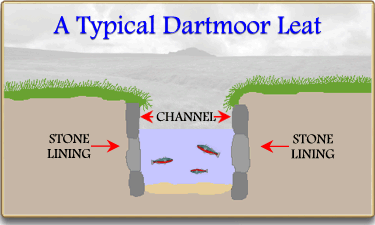
Everyone gets a day when they just want to take things easy, be out in the Dartmoor landscape enjoying all it has to offer without the hassle of slogging up hill and down dale. Alternatively you may be new to exploring Dartmoor and initially a bit nervous about venturing out into its wilds. In either case a local author called John Robins came up with the ideal solution in 1982 when he published his book – ‘Follow the Leat’.
John was born in Plymouth in 1905 where he attended the Devonport High School and on leaving this he joined what was then the Eastern Telegraph Company, a job which took him to various overseas locations. He served the company for 39 years during which time he was taken prisoner by the Japanese in Sumatra, spending 4 years in captivity. He was later awarded the British Empire Medal for services to his fellow internees and retired in 1961. Following his retirement he moved to Tavistock but unfortunately he immediately suffered a heart attack. His recuperation eventually lead him to begin to explore Dartmoor and in the summers of 1797, 1980 and 1981 he covered all the areas which were later listed in the book. He was also a staunch member of the Devonshire and Dartmoor Preservation Associations. In his opinion his return to good health was due to his numerous walks around the moor and maybe here is a lesson for us all?
In his introduction to the book he wrote the following; “So, in many of the river valleys and often on the open moor, the chances are that you will come across leats, and it is an intriguing and rewarding experience to walk them from end to end. Some are still in use. Most have been dry for years, some for centuries and almost unrecognisable. In most cases the walks will not be difficult for one is walking on the level. Well almost on the level, for water must of course flow downhill, though there are places where one would swear that it was going uphill,” 1982, p.9. So, bonus number one, if you fancy a lazy day then following a leat will mean you are walking mainly on the level. Bonus number two, if you are slightly wary of venturing into unknown places then you will always have something to follow and able to retrace your steps should something unforeseen happen.
In this publication Robins described five leat courses; Wheal Emma and Holne Moor leats, the Devonport leat, Birch Tor and Vitifer leats, the Eylesbarrow Mine leat and the Whiteworks systems of leats. By following these walks one would have been guided around many varied Dartmoor landscapes with many of the landmarks and aspects of the area described. The various routes ranged from 1.5 miles to 10 miles with the average being around 4 miles. As a generous gesture, all of the proceeds from the book were donated to the Leonard Cheshire Foundation in Plymouth.

Following the publication of his book Robins began to receive numerous communications from folk which contained new information regarding the various leats and mines and in some cases corrections. This along with some further walks from Robins lead to another publication in 1984. Once again the title was ‘Follow the Leat‘ but with the addition of the words; “A new revised and enlarged edition.” The original version contained 64 pages whereas the new edition had more than doubled in size to 184 pages. Not only was there much more information and photographs but each leat walk was accompanied by a map of its course along with the various landmarks along it. Other improvements, if that is the right word, included the addition of two more leat walks; the Grimstone and Sortridge leat and the Wheal Friendship and Wheal Jewell leats. There were also additional locations added to the previous leat walks along with specific investigations into Wheal Katherine, the False Cutting and the leat which crossed Langcome Foot. As with the previous edition all the proceeds of the publication were donated to the Leonard Cheshire Foundation.

Slightly off topic now but these two books were not the end of John Robins’ writing career for in 1988 he published another book called ‘Rambling on with John Robins’. This work was described as being; “A Dartmoor miscellany of explorations, reminiscences and a fantasy tale of a vanishing valley.” The first part of the book contains nostalgic accounts of some of his memorable walks. The second section encompasses walks of investigation which in the main are about leats and mines. The final instalment of the book is fictional tale set in the Deancombe Valley.
I have no idea if there is any connection but having written a fictional tale John Robins’ last publication in 1991 was a historical novel called ‘Classywell’s Secret’. This told the tale of the loves and life of a Cornish miner with the action moving from Ellisborough mine to a prisoner of war hulk ship at Plymouth.
In conclusion, I can thoroughly recommend reading and exploring with ‘Follow the Leat’ it is guaranteed that you will be taken on some leisurely walks with plenty of interest along the way. The author will guide you through various Dartmoor landscapes which range from the North Moor down to the South Moor. You will travel through both remote high moors and the gentler lower inhabited commons – all exhilarating and memorable. As an example of what DELIGHTS these walks provide you can see but one example when I walked along the Devonport leat from Whiteworks to Crazywell Pool – HERE.

Robins, J. A. C. 1982. Follow the Leat. Callington: Penwell Ltd.
Robins, J. A. C. 1984. Follow the Leat. Callington: Penwell Ltd.
Robins, J. A. C. 1988. Rambling of with John Robins. Pembury: John Pegg Publishing.
Robins, J. A. C. 1991. Classywell’s Secret. United Writer’s Publications Ltd.
 Legendary Dartmoor The many aspects past and present of Dartmoor
Legendary Dartmoor The many aspects past and present of Dartmoor

Good Morning Tim,
My name is Graham Dell and i work as a Project Manager at The Coal Authority dealing with legacy mining operations. I am working at an old copper mine in Coniston and am l am keen to understand the use of leats a bit more as they may be able to play a key role in remediation work to prevent the migration of metal waste into watercourses. Are you aware of any restoration / preservation work that has occurred in your neck of the woods on these fantastic bits of engineering?
Thanks for any leads.
Regards
Graham Dell
Try the Dartmoor National Park Authority or The Dartmoor Preservation Society.